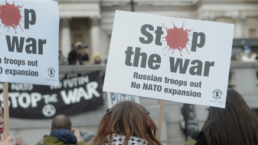Russia’s brutal invasion complicates the left’s decadeslong effort to untangle Europe from the U.S.-led military alliance.
By Alice Speri, The Intercept
On a single day in the fall of 1983, some 400,000 people took to the streets across Belgium to protest nuclear proliferation and the North Atlantic Treaty Organization. The protest was one of scores of mass demonstrations in Western Europe amid an escalating Cold War, as citizens of NATO member countries called for an end to the military alliance and U.S. dominance in it. Twenty years later, when the U.S. invaded Iraq over the objections of several NATO allies, protesters in Europe and across the world numbered in the millions — one of the largest anti-war protests ever.

But when peace activists in Belgium called for a mobilization last month in the aftermath of Russia’s invasion of Ukraine and of the military aid that U.S. and European countries sent to Kyiv, the numbers were far smaller. It was the same elsewhere in Europe. While anti-war demonstrations in some countries were larger, they hardly compared to the mass mobilizations against the Iraq invasion.
“We had maybe three, 4,000 people, which is not many,” Ludo De Brabander, a member of Belgian peace group Vrede vzw, told The Intercept. “It was difficult to mobilize.”
“Iraq was very clear: It was an aggressive war based on false arguments,” he added. In Ukraine, by contrast, it was Russia that had staged an illegal, unprovoked invasion, and U.S.-led support to Ukraine was understood by many as crucial to stave off even worse atrocities than those the Russian military had already committed. That has left peace activists scrambling, said De Brabander, “because we don’t want to support NATO. And of course, we also oppose what Russia is doing. And a position in between, with alternatives to war, is very difficult to sell.”
As a result, the messaging at the European protests in March was at times confused and inconsistent: Some were filled with Ukrainian flags and explicitly in support of the Ukrainian people and their resistance. Others displayed the rainbow “peace” flag ubiquitous in Europe during the Iraq War and featured calls against increased military spending and the prospect of NATO expansion.
Recent Posts
‘Unconstitutional. Unethical. Authoritarian.’ ICE Bars Millions Of Immigrants From Bond Hearings
July 18, 2025
Take Action Now One watchdog said the new policy “seems like a blatant attempt to stop them from exercising their right to due process.”……
Americans Are Not Nearly Alarmed Enough About Climate Change
July 18, 2025
Take Action Now Americans still don’t comprehend how imminent, dangerous, and far-reaching the threat is—and journalists are partly to blame.By…
The IRS Is Building A Vast System To Share Millions Of Taxpayers’ Data With ICE
July 17, 2025
Take Action Now ProPublica has obtained the blueprint for the Trump administration’s unprecedented plan to turn over IRS records to Homeland Security…
Israel’s Sudden Assault On Syria Is Unchecked Aggression
July 17, 2025
Take Action Now Jerusalem is bombing Damascus and threatening al-Sharaa’s rule, while Washington was hoping to help the nascent government on…




